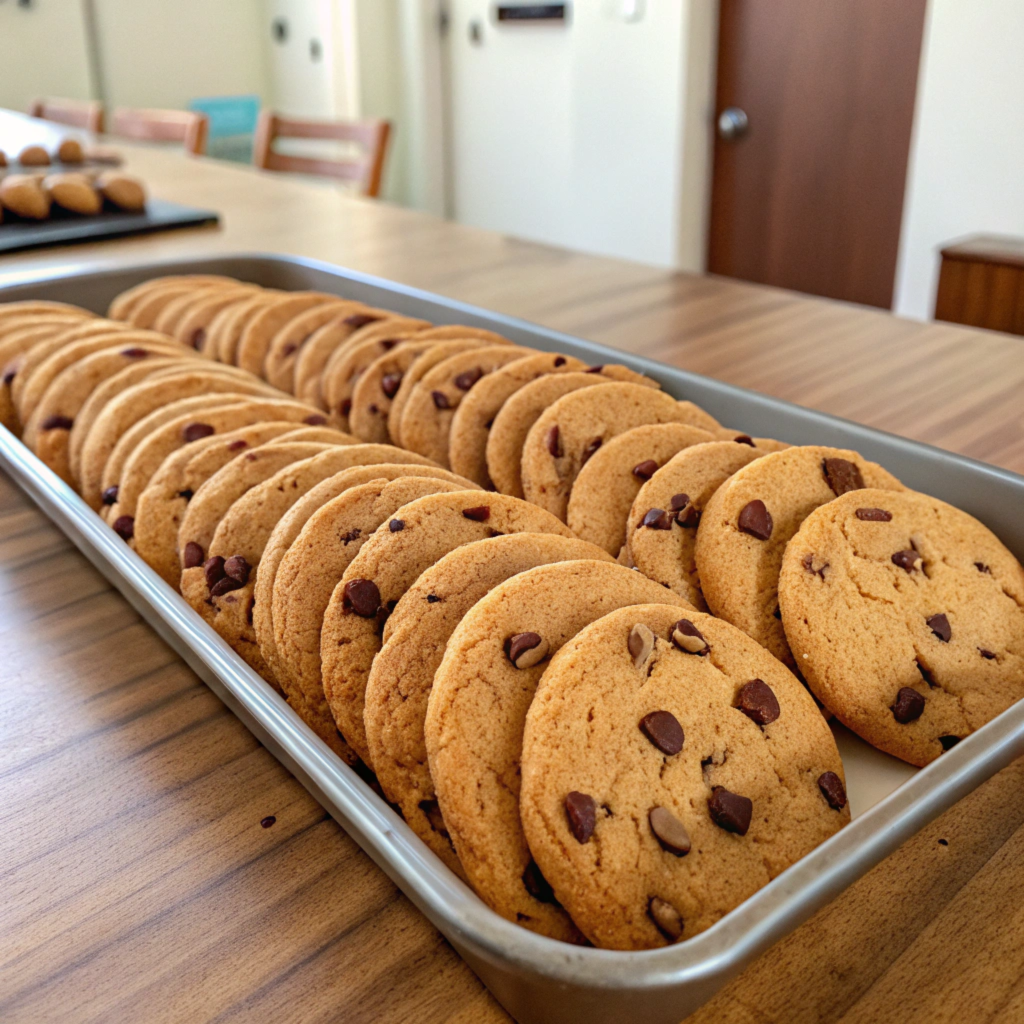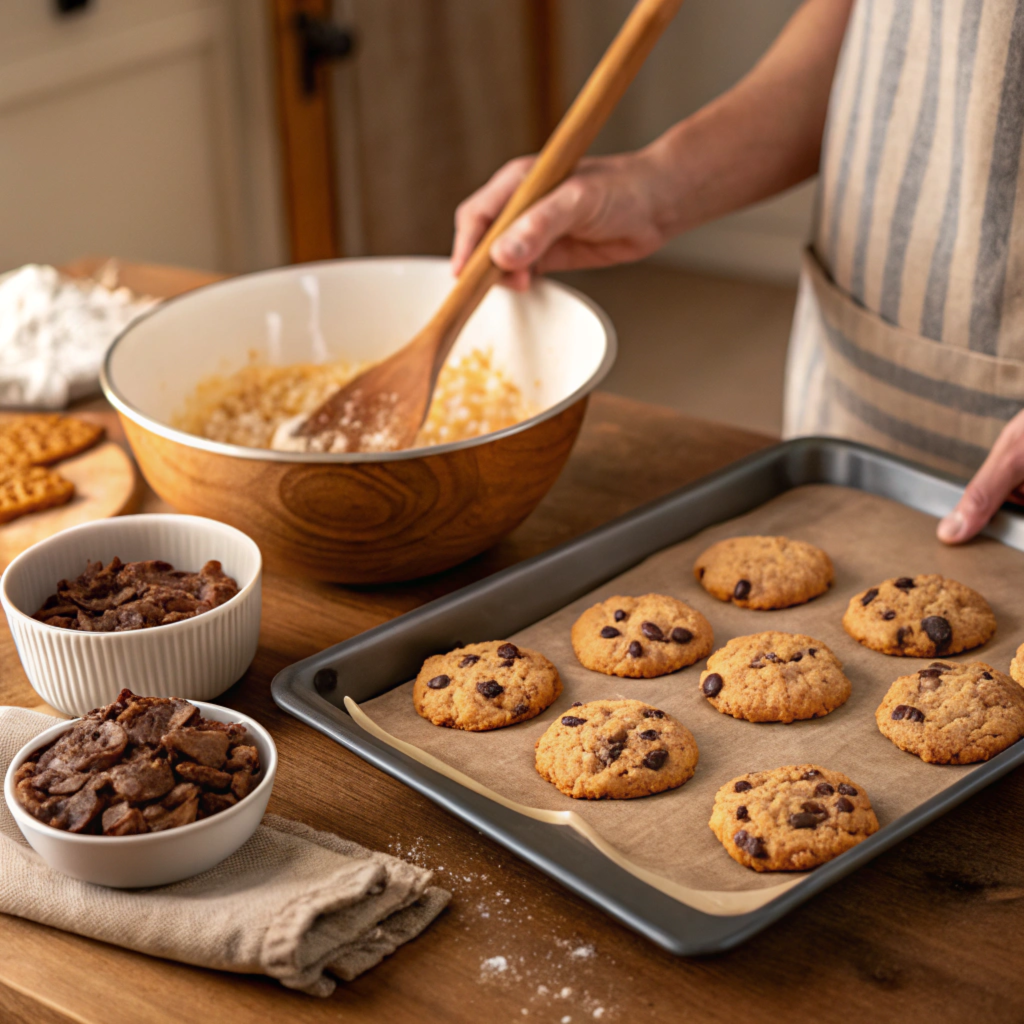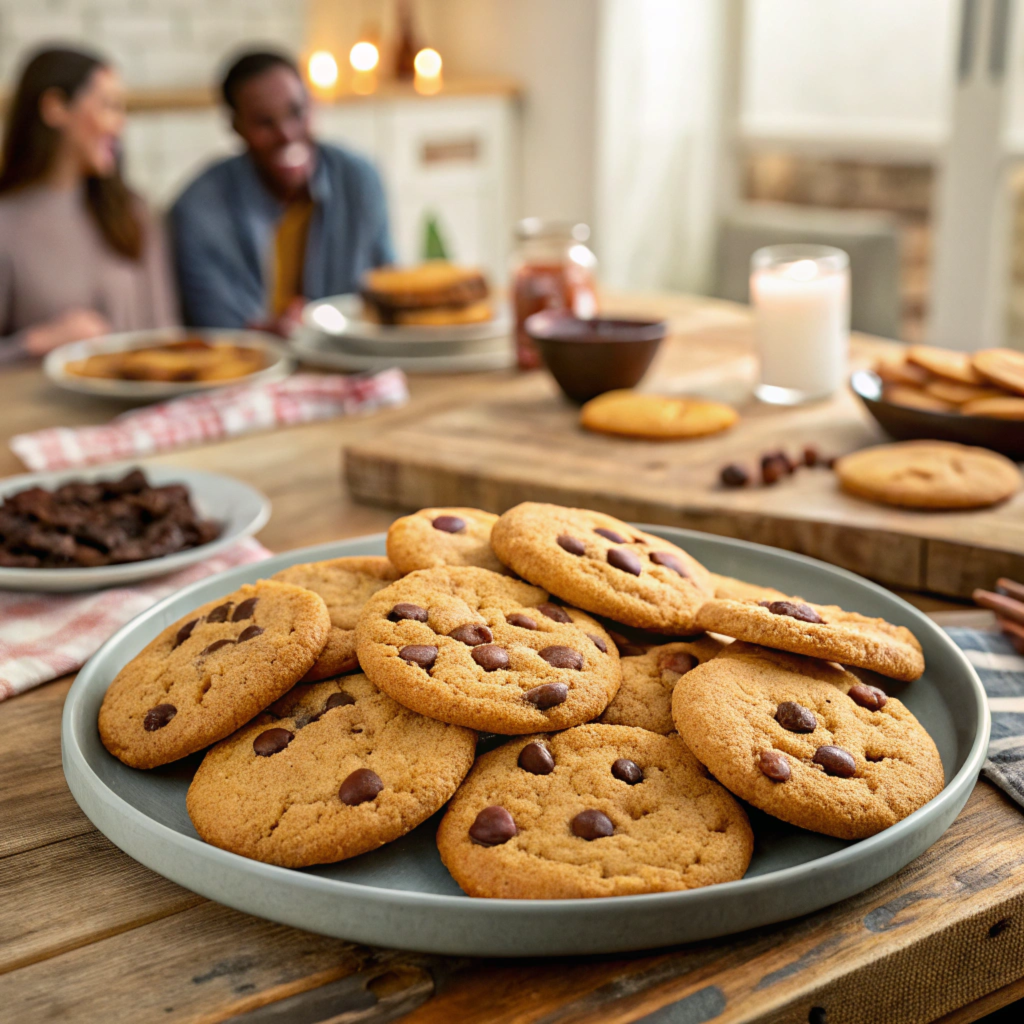
Why Do Cookies Go Flat?
Homemade chocolate chip cookies are a classic treat, but encountering a batch that turns out flat instead of plump and chewy can be frustrating. Flat cookies often result from an imbalance in the ingredients or mistakes during the baking process. Too much butter, not enough flour, or an incorrect oven temperature are common culprits. Even small errors, such as using melted butter instead of softened butter, can lead to cookies spreading excessively in the oven.
Flat cookies aren’t just an aesthetic issue—they also lack the desired texture. While some people enjoy thin, crispy cookies, others prefer thick, chewy ones that provide a satisfying bite. Understanding why cookies go flat helps bakers troubleshoot issues and adjust their methods to create the perfect cookie.
The Importance of Understanding Baking Science
Baking is both an art and a science. To achieve consistent results, bakers need to understand how ingredients interact and influence the final product. Each component in a cookie recipe serves a specific purpose. For example, butter provides flavor and assists in spreading, while flour offers structure. Sugar adds sweetness and determines how much the cookie spreads, and eggs help bind the ingredients together.
Temperature also plays a crucial role. The heat in the oven causes butter to melt, sugar to caramelize, and leavening agents like baking soda to release gas, which creates air pockets in the dough. If the oven temperature is too low, cookies may spread before they set. Conversely, if it’s too high, the cookies can burn on the edges while remaining undercooked in the center.
Baking science also allows bakers to refine their techniques. For instance, chilling the dough before baking can help control spread, as colder dough takes longer to melt in the oven. Similarly, using a kitchen scale for precise measurements can prevent errors that lead to flat cookies.
Conclusion
Understanding why cookies go flat and the role of baking science can transform your results. By mastering the interaction between ingredients and techniques, you can troubleshoot common problems and consistently bake cookies that are thick, chewy, and perfectly golden. With this knowledge, every batch you bake will not only taste better but also look picture-perfect.
The Role of Butter in Cookie Structure
Butter is a key ingredient in chocolate chip cookies, and its handling can make or break the final product. When butter is too soft, it melts quickly in the oven, causing the cookie dough to spread excessively. This often results in flat, thin cookies. On the other hand, using butter straight from the fridge can lead to uneven mixing, as it doesn’t cream well with sugar. Achieving the right consistency—softened but not melted—is critical.
The type of butter also affects the cookie structure. Unsalted butter is typically recommended for baking because it allows for better control over the recipe’s salt content. Substituting butter with margarine or shortening can yield different results. Margarine, with its higher water content, promotes more spreading, while shortening produces taller cookies due to its higher melting point. Understanding butter’s role is essential for achieving the right cookie texture and spread.
How Sugar Affects Cookie Spread
Sugar is not just a sweetener; it significantly impacts how cookies spread. Granulated sugar, with its coarse texture, creates cookies that spread more, resulting in a crispier texture. Brown sugar, which contains molasses, adds moisture and chewiness. Using more brown sugar in a recipe can help create thicker, softer cookies.
The ratio of sugars in the recipe is also crucial. A higher proportion of granulated sugar leads to flatter cookies, while a balance of brown and white sugar gives the ideal mix of spread and texture. The type of sugar matters too. For instance, fine caster sugar dissolves quickly, creating smoother dough, while coarser sugars take longer to break down, impacting the cookie’s final structure. Adjusting sugar types and amounts can help tailor cookies to your desired outcome.
The Science of Flour and Baking Soda
Flour provides the structural foundation of cookies, determining how well they hold their shape during baking. All-purpose flour is commonly used for its moderate protein content, which balances chewiness and tenderness. Using too little flour results in cookies that lack structure and spread too much, while too much flour can make cookies dense and dry.
Baking soda, a leavening agent, plays a critical role in cookie texture. It reacts with acidic ingredients like brown sugar to produce carbon dioxide, creating air pockets that make cookies light and soft. However, using too much baking soda can lead to cookies spreading excessively and developing an undesirable soapy taste. Proper measurement of both flour and baking soda ensures cookies rise correctly and maintain their shape.
Eggs: The Unsung Heroes of Cookie Stability

Eggs are multifunctional in cookie baking. They act as binders, hold moisture, and provide leavening. Egg whites contribute to the cookie’s structure, while yolks add richness and tenderness. An imbalance, such as too few eggs, can lead to cookies that crumble and spread too thin. Too many eggs, on the other hand, result in cakier cookies that don’t spread as expected.
For best results, eggs should be at room temperature before being added to the dough. This ensures they incorporate evenly and improve the emulsification of fats and liquids. Mastering the use of eggs in cookie recipes can significantly enhance stability and texture.
Conclusion
The balance of ingredients like butter, sugar, flour, and eggs is vital for creating chocolate chip cookies with the perfect texture and shape. By understanding how each component interacts, bakers can fine-tune recipes to avoid flat cookies and achieve the ideal balance of chewiness, crispiness, and thickness. With precise measurements and thoughtful adjustments, every batch can turn out exactly as desired.
Part 3: Common Mistakes Leading to Flat Cookies
Measuring Ingredients Incorrectly
Precision is key in baking, and one of the most common mistakes that leads to flat chocolate chip cookies is inaccurate ingredient measurement. Using too much butter or too little flour can disrupt the balance of the dough, causing it to spread excessively during baking. For instance, if the dough lacks enough flour, it won’t have the structure needed to hold its shape, resulting in flat, thin cookies.
To avoid this, always measure ingredients with accuracy. Use a kitchen scale for precise measurements instead of relying on cups, as flour can compact differently depending on how it’s scooped. Spoon flour into the measuring cup and level it off with a knife to ensure consistency. When measuring butter, ensure it’s at the correct weight according to the recipe. Proper measurements ensure the dough has the right consistency for evenly shaped cookies.
Using the Wrong Baking Sheet
The type of baking sheet you use can significantly impact the outcome of your cookies. Thin or dark-colored baking sheets tend to conduct heat unevenly, causing cookies to spread too quickly. This often results in cookies that are flat and overcooked at the edges. On the other hand, using a heavy-duty, light-colored baking sheet promotes even heat distribution, which helps cookies retain their shape.
Lining your baking sheet with parchment paper or a silicone baking mat can also prevent cookies from sticking and encourage even baking. Avoid greasing the baking sheet, as it can create a slippery surface that leads to excessive spreading. By selecting the right baking sheet and lining, you can ensure consistent results.
Overmixing or Undermixing the Dough
The way you mix your cookie dough directly affects the texture and spread of the cookies. Overmixing the dough develops too much gluten, which makes cookies tough and causes them to spread unevenly. Conversely, undermixing leaves pockets of unmixed butter or sugar, resulting in uneven baking and inconsistent cookie shapes.
To mix dough properly, start by creaming the butter and sugar until light and fluffy, which helps incorporate air for a tender texture. Gradually add the dry ingredients and mix just until combined. This method prevents overworking the dough while ensuring all ingredients are evenly distributed.
Baking at Incorrect Temperatures
Temperature errors, whether in the dough or the oven, are a major contributor to flat cookies. Baking at a temperature that is too low allows the butter to melt before the cookie structure sets, leading to excessive spreading. Alternatively, a too-hot oven can cause cookies to bake too quickly on the outside while remaining undercooked inside.
Invest in an oven thermometer to ensure your oven is calibrated correctly. Preheat the oven fully before placing the cookies inside, and follow the recipe’s specified baking temperature. Additionally, chilling the dough before baking can help control spreading, as cold dough takes longer to melt in the oven.
Conclusion
Avoiding common mistakes such as inaccurate measurements, improper mixing, and incorrect baking temperatures is essential for baking perfectly shaped chocolate chip cookies. By taking the time to understand and correct these issues, bakers can ensure their cookies are thick, chewy, and consistently delicious. Careful attention to detail in every step of the baking process will make flat cookies a thing of the past
High Altitude Baking Challenges
Baking cookies at high altitudes presents unique challenges that often lead to flat chocolate chip cookies. At higher elevations, the air pressure is lower, which causes liquids to evaporate more quickly and baked goods to rise faster. This rapid expansion and evaporation often result in cookies that spread excessively and lose their structure.
To counteract these effects, adjustments to the recipe are essential. For instance, increasing the amount of flour helps provide more structure, while reducing sugar prevents excessive spreading. Adding a bit more liquid, such as an extra egg yolk or a splash of milk, can help retain moisture. Additionally, lowering the baking temperature slightly allows the cookies to set before spreading too much. High-altitude baking requires experimentation, but these tweaks can result in perfectly thick and chewy cookies.
Kitchen Temperature and Dough Consistency
The temperature of your kitchen and ingredients significantly impacts cookie dough consistency and baking outcomes. In a warm kitchen, butter softens too much, making the dough overly sticky. This causes cookies to spread excessively in the oven. Conversely, in a cold environment, butter may not cream properly, resulting in a dense dough that doesn’t spread enough.
To mitigate these issues, chill the dough if your kitchen is warm. Chilling firms the butter, allowing the cookies to bake more evenly and retain their shape. If your kitchen is cold, let butter come to room temperature naturally before creaming it with sugar. Controlling the temperature ensures dough consistency and prevents flat cookies.
The Importance of Oven Calibration
An improperly calibrated oven is a common but often overlooked factor in flat cookies. If the actual oven temperature is lower than the displayed temperature, cookies may spread before they set. Conversely, an oven running too hot can cause the edges to brown too quickly, leaving the centers undercooked and flat.
Investing in an oven thermometer is the simplest way to ensure accuracy. Check your oven’s temperature before baking and adjust as needed to match the recipe requirements. Regular calibration ensures that your cookies bake evenly and hold their shape.
Humidity Levels and Dough Moisture
Humidity plays a subtle but significant role in baking cookies. In high-humidity environments, flour can absorb moisture from the air, resulting in dough that is too wet and spreads too much during baking. On the flip side, low humidity can dry out the dough, making it too stiff to spread properly.
To address humidity issues, store your flour in an airtight container to prevent moisture absorption. If the dough seems too wet, adding a tablespoon of flour at a time can help achieve the right consistency. In low-humidity conditions, consider reducing flour slightly or adding a teaspoon of liquid to balance the dough.
Conclusion
Environmental and situational factors, such as altitude, kitchen temperature, oven calibration, and humidity, play critical roles in the success of your chocolate chip cookies. By understanding and adjusting for these variables, bakers can overcome challenges and achieve perfectly shaped cookies every time. Attention to these details ensures consistent results, even in less-than-ideal conditions.
Chilling the Dough: A Simple Yet Effective Solution

Chilling cookie dough before baking is one of the easiest and most effective ways to prevent flat chocolate chip cookies. When dough is chilled, the butter solidifies, which slows the melting process in the oven. This allows the cookies to maintain their shape and prevents excessive spreading. Chilling also gives the dry ingredients time to absorb the liquid, leading to a firmer dough.
For best results, chill the dough for at least 30 minutes, though longer chilling—up to 24 hours—can enhance flavor and texture. If the dough has been refrigerated for an extended time, let it sit at room temperature for a few minutes before scooping to make it easier to handle. By chilling the dough, you ensure thicker, more structured cookies with a deliciously chewy texture.
The Right Way to Cream Butter and Sugar
The creaming process is a foundational step in cookie baking that significantly impacts the outcome. Properly creamed butter and sugar create air pockets in the dough, which contribute to the cookies’ rise and texture. However, over-creaming can cause the butter to become too soft, leading to flat cookies.
To cream butter and sugar correctly, start with softened—not melted—butter. Use a mixer on medium speed to combine the butter and sugar until the mixture is light and fluffy, usually 2-3 minutes. Avoid overmixing, as this can break down the butter too much, leading to excessive spreading. Mastering this technique ensures the cookies have the perfect balance of fluffiness and structure.
Choosing the Best Cookie Scoop for Even Baking
Using a cookie scoop ensures uniformity in size and shape, which is essential for even baking. When cookies are different sizes, smaller cookies tend to overbake while larger ones remain undercooked. A cookie scoop eliminates this issue, making it easier to achieve consistently thick cookies.
Choose a scoop size that matches the recipe’s recommendations, typically ranging from one to two tablespoons for standard cookies. Level off the scoop to ensure each portion is consistent. This small investment can make a big difference in the appearance and texture of your cookies, preventing uneven spreading and ensuring a professional-looking batch.
Testing with Small Batches First
Baking a small test batch before committing to the entire dough can save time and frustration. A test batch allows you to evaluate how the dough behaves in your specific baking environment. If the cookies spread too much, you can adjust by adding a tablespoon or two of flour or chilling the dough longer.
This technique also helps identify potential issues with your oven temperature or baking sheet. Small adjustments made early ensure the rest of the batch turns out perfectly. Testing with a few cookies first is a simple but effective way to troubleshoot and refine your baking process.
Conclusion
Preventing flat chocolate chip cookies requires attention to detail and a few simple techniques. Chilling the dough, creaming butter and sugar correctly, using a cookie scoop, and testing with small batches are all strategies that can make a significant difference. These steps ensure your cookies turn out thick, chewy, and picture-perfect every time. With a little preparation and practice, you’ll consistently bake cookies that are as beautiful as they are delicious.